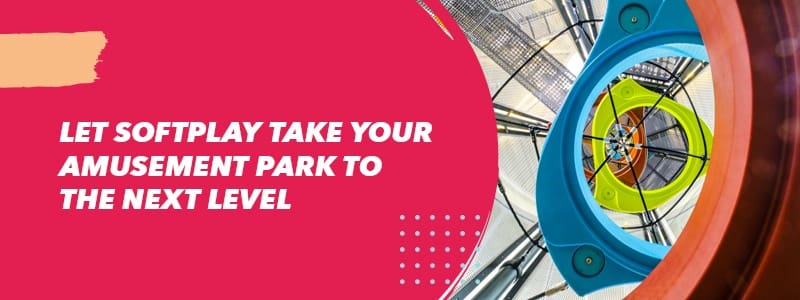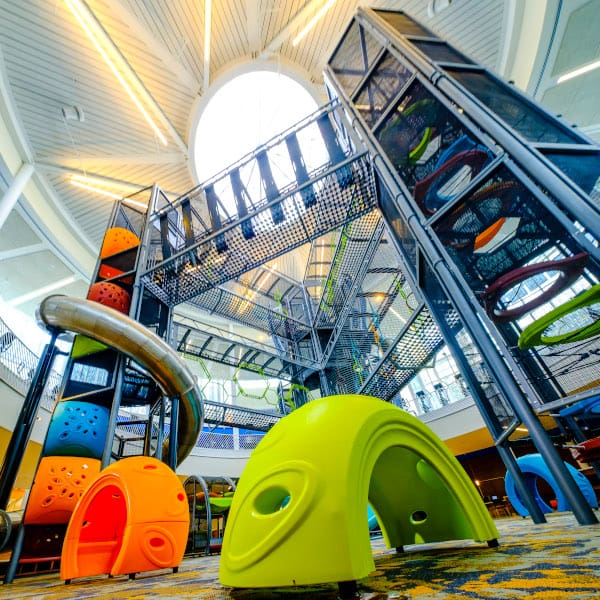How to Start an Amusement Park
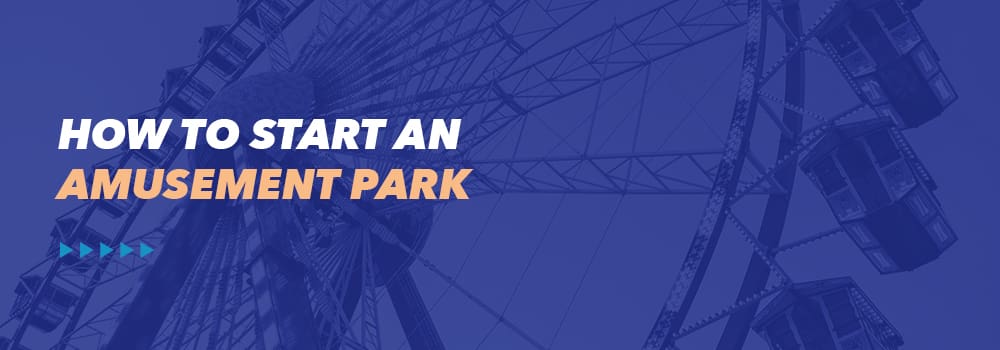
How to Start an Amusement Park
If you’re in the business of thrills and family fun, creating an amusement park is the perfect opportunity to bring imaginative excitement to a community near you. Theme parks immerse guests in a variety of adventures, from high-flying rollercoasters to kid-friendly rides and innovative play structures.
Whether you already have an abundance of amusement park ideas or are looking for some inspiration, this guide is a comprehensive checklist for planning and designing your park from start to finish.
Planning Your Amusement Park
Before you design and build your theme park, you’ll want to plan your business framework. Creating a detailed plan will help you know how much you can budget on an awesome design while creating a successful business that turns a profit by engaging a community.
Choosing the Type of Park
One of the very first aspects to consider is the kind of park you’re looking to create. Many amusement parks feature several large rollercoasters as their main attraction. To appeal to all age groups and interests, you can also include secondary attractions such as water parks, safaris, kids’ rides and ropes courses.
You’ll also want to determine whether your park will have indoor components. While most outdoor amusement parks use vast space to accommodate several large rides, including some indoor spaces can benefit your business plan. Indoor amusement park attractions can boost attendance at your park by introducing visitors to new thrills, from multi-storied playgrounds to interactive games and structures unique to your establishment. Guests can relax in air conditioning on hot, sunny days, or keep the fun going on rainy afternoons.
Choosing a Theme
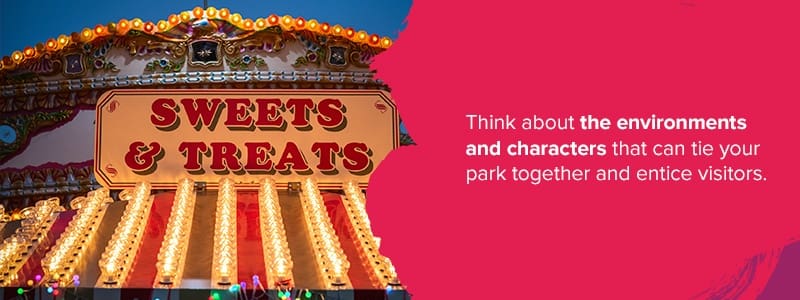
An inviting amusement park begins with an exciting theme. Think about the environments and characters that can tie your park together and entice visitors. Maybe create an animal mascot that can lead people through your park, or dream up a series of scenarios based on a time period or story guests can connect to.
Make sure your theme is interesting and accessible to kids and adults of all ages. When families are looking to do something together, an interesting theme can help everyone find something to enjoy, from little kids and older siblings to teenagers and adults.
Using variations on a consistent theme throughout your park is a fun way to provide a variety of amenities. After you’ve decided on a theme, implement it in all your attractions. Set the scene by adding buildings and other structures that transport guests to another world and design rides around adventures associated with your theme. Go the extra mile by adding eating areas and carnival games with themed prizes and food options.
Making a Business Plan
While you always want to keep your eye on the thrills, creating a theme park is also a business endeavor. Plan your theme park the way you’d plan any other business to ensure your park can successfully operate for years to come.
Conduct market research to determine who your audience is and how your park will fit in within the amusement park industry. Then, calculate your projected costs.
Based on your construction and operation costs, determine guest costs. As yourself questions such as:
- Will you offer sales of individual tickets per ride or a flat rate to enter the park and ride most attractions?
- How much will tickets cost per person or per ride?
- Will you have a senior or child discount?
- Will you offer group or family rates?
- Will you sell season passes?
- Will secondary attractions require a separate entrance fee?
When considering costs, also factor in your park’s operation schedule by considering questions such as:
- What days of the week will you be open, and on what hours per day?
- What months of the year will you be open?
- Will your park be located in an area where you’d need to close for a season or adjust your operations due to cold or snowy weather?
- If you stay open year-round, will you provide seasonal attractions such as Halloween haunts or holiday lights?
Once you have an idea of your projected costs and income, you’ll be able to design a park that’s both profitable and enjoyable.
Finding Investors

Much of your financial support when creating and running your amusement park can come from investors. The most crucial step in finding people who will help turn your plans into reality is pitching your plans.
When pitching your theme park to potential investors, emphasize the benefits they’ll receive by supporting your business. Why is investing in your park a worthy endeavor? What needs will your park meet? What can you promise as a return on investment?
In your pitch, remember to keep your main points short and concise, and deliver a business plan full of clear, persuasive facts so your investors can make educated decisions about whether to support your amusement park.
Determining Marketability
All of your initial planning determines your theme park’s marketability. Before you move into the design stage, specify your top selling points so you can refer back to them as you define your details. What’s going to make your park stand out from the rest? What new, desirable features are you providing to your community? Why will people pay to visit your amusement park?
Starting Your Business

As you prepare to start your business, define what a successful amusement park will look like in your eyes. Will you want attractions that are profitable and fun at the same time? Are you looking to create a place that will cover its own costs? If you want to expand in the future, maybe your version of success will include making enough of a profit to afford additional attractions down the line.
After you have a substantial plan, make a tentative timeline. Creating an amusement park takes time, but with efficient work, you’ll set your vision into motion. Whatever you value as a business, you can make design and operation decisions to help you reach your goals as soon as possible.
Designing Your Amusement Park
To start designing your park, you’ll need to look at your business plan and determine how much of your budget you can dedicate to land purchases, buildings, rides and other elements. By sticking to your plans, you’ll discover how to best realize your ideas in a quality fashion while leaving funds for other important facets, such as design team salaries and initial operating costs.
Creating a Design Team
Once you have your plans in order, gather a team of people to help bring them to life! Hire an innovative crew to work on everything from your park’s layout to the rides you’ll have and how you’ll implement your theme. Theme park design requires creative, dedicated people at every step of the process, from engineers who will draw up plans to crews who will build those designs.
Hire architects, engineers, construction workers and various other project representatives who appreciate your vision and will work with you to see it through. In these initial design phases, your design team will come up with preliminary ideas and concepts that align with your business goals. They’ll also do research on your potential locations and combine their findings with your business plan to create designs that are profitable from a business standpoint and enticing from a visitor’s point of view.
Choosing a Location
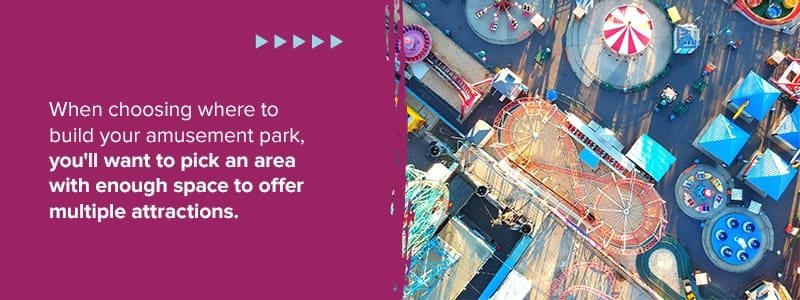
Your amusement park’s location will be a major selling point. Consider locations near big cities or populated areas or locations that are a little more remote but easy to travel to.
When choosing where to build your amusement park, you’ll want to pick an area with enough space to offer multiple attractions. Big, open, undeveloped spaces provide the perfect opportunity for a sprawling theme park.
Your location will also determine much of your theme park’s design. Are there mountains in the distance you’ll want rollercoaster riders to overlook as they creep to the top of the highest drop? Does the land include a lake that would make a good central focal point? You’ll want to make sure your location has enough space to incorporate your designs, but you can also use the location’s natural landforms to your advantage.
Planning a Layout
When planned effectively, your theme park’s layout can be both profitable and fun. Create an interesting yet easily navigable network of rides and other attractions by considering:
- Front entrance: At the front of your park, station important offices such as first aid, security and lost and found. Make these buildings visible and accessible from the main paths.
- Meeting places: Many theme parks have one or two prominent features near their entrances that people can use as meeting places in case groups get split up or people get lost. Consider adding a statue of your mascot or a large fountain that members of families, school classes and other groups can safely wait near.
- Necessary facilities: Include bathrooms and food stands throughout your park to help meet people’s basic needs wherever they are. Also include accessible ramps and other features to help people with mobility issues to enjoy your park.
- Strategic pathways: Souvenir shops and carnival games scattered throughout your park are another way to keep your theme alive and pique guests’ interests as they wander through the world you’ve created.
- Park exit: Place main souvenir shops towards the park’s exit so as guests leave, they’ll want to buy souvenirs to remind them of their visit.
When planning your layout, make sure large attractions are right off of main pathways. Map out how a typical visitor might make their way through your designs. Creating a circular pathway around your park or implementing several main roads will help prevent bottlenecking around major attractions.
It may also be a good idea to spread out similar rides around your park. For instance, if you’re going to include five big rollercoasters, placing them in five different sections at the edges of your park can encourage visitors to explore many other attractions along the way.
Determining Ride Areas
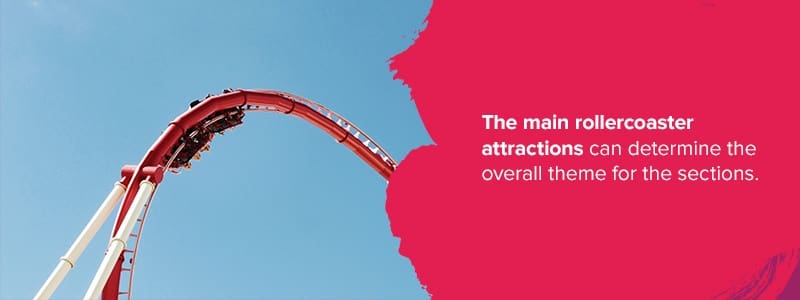
Theme parks often have several distinct sections, usually all with their own themes that echo the park’s umbrella theme. Layout planning, as well as intentional theme design, can help each individual section stand out and provide new appeals for guests while immersing them in the overall park excitement.
The main rollercoaster attractions can determine the overall theme for the sections. Draw guests in with unique coasters that tower over the rest of the park, inviting teenagers and adults to take fun risks.
While older kids and adults will love the fast-paced thrills of rollercoasters, younger kids and toddlers will benefit from more age-appropriate forms of excitement. Create a few designated kids’ areas throughout your park, full of colorful themed elements and a variety of exciting rides. Young kids will also love the opportunity for free play on a variety of playground structures.
Creating Accessibility
Your amusement park should be welcoming and fun for people of all ages, interests and abilities. When creating an amusement park, follow the latest ADA standards to ensure every aspect of your park is accessible and enjoyable for all guests.
Accessibility standards provide opportunities for people with wheelchairs and other disabilities to engage in your park’s exciting amenities. Theme park regulations and standards address inclusive design features such as rides with wheelchair spaces, rides with transfer seats, adequate space for loading and unloading wheelchairs and paved pathways for easy wheelchair use.
When designing and building your park, keep in mind the many ways you can go above and beyond to provide a fun experience to guests with disabilities.
Purchasing Playground Products
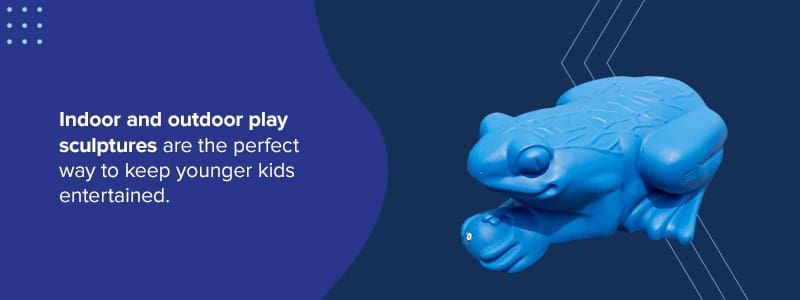
Fun for the whole family is possible through innovative attractions people of all ages can enjoy. A variety of playground products is the perfect way to help your amusement park stand out and stay relevant to many age groups. With customizable options, you can create a one-of-a-kind, interactive play experience that immerses visitors in your park’s theme and provides kids too young for rollercoasters with an exciting alternative.
You can feature different playgrounds indoors or outdoors to expand your park’s marketable areas and add thrills for guests wherever they are.
Some playground products to consider include:
- Belayed adventure courses: For older kids and adults, the thrills of riding high on a rollercoaster can continue with daring belayed ropes courses set high above your park. Families can have fun and work together to navigate across obstacles such as cargo nets, wobbling bridges, tightropes and ziplines, all while moving between platforms on harnesses.
- Non-belayed adventure courses: Create an exhilarating free-play environment with a multi-story course full of climbing challenges and other fun obstacles. Non-belayed courses include features such as innovative rope ladders, hanging rings and twisty slides, all enclosed by netting that makes for an additional walking and climbing challenge.
- Gamified obstacle courses: If your amusement park includes an indoor entertainment center, the Hive interactive challenge course is the perfect way for families to continue the fun. Teams compete against each other to win points by climbing through obstacles and collaborating on strategies. Younger family members can also join in the excitement by playing on brightly colored climbers on the game floor.
- Sculpted play elements: Indoor and outdoor play sculptures are the perfect way to keep younger kids entertained. Customized foam play sculptures turn your park’s theme into an interactive adventure even the youngest kids will enjoy.
- Play structures and towers: Adding a classic playground structure gives energetic kids a chance to use their imaginations and engage in active play. Choose from innovative designs that will excite kids and give adults time to rest.
Designing Rollercoasters
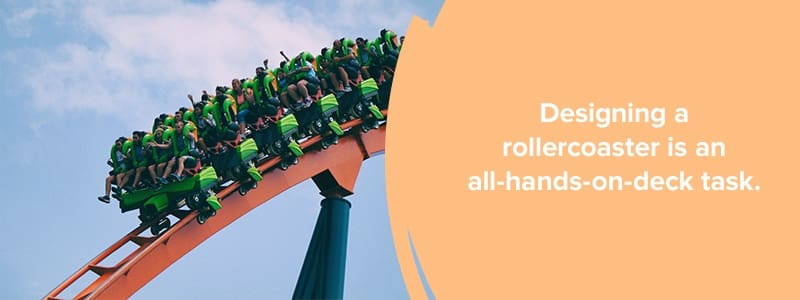
Your park’s main attraction will be its thrills. Create several thrill levels with a variety of rollercoasters. When designing coasters, keep in mind:
- Originality: Part of your park’s appeal will come from the quality of thrills you offer. In your market research, see what your competitors are doing, and create attractions that are even more unique. Guests will love visiting a park that gives them new experiences they can’t find anywhere else.
- Timeline: When deciding when to open your amusement park, keep in mind that rollercoasters take time to complete. First, designers must come up with coaster concepts, then conduct several studies to make sure the concepts are compatible with the coaster’s future location. From there, they draft designs and then build the coaster, which could take a few years, depending on how complex the designs are.
- Team: Designing a rollercoaster is an all-hands-on-deck task. Most coasters are a collaboration between many types of engineers, including coaster, project, design, electrical, structural and mechanical engineers. Gather a team of experts who work well together to bring ideas to fruition.
Opening Your Amusement Park
After careful planning and building, your amusement park will be almost ready for opening day. To ensure a smooth and profitable start to your park’s legacy, take these steps to put everything in order:
Marketing Your Park
Once your amusement park is close to becoming a reality, you’ll want to invite the world to visit. Advertise with a variety of platforms that will appeal to your target audiences, highlighting your most interesting attractions. When used correctly, a solid marketing strategy can go a long way.
When marketing your amusement park, provide clear information so people know exactly how to buy tickets and access your park. Be sure to let the world know about your theme and the many age group features you offer while leaving some details a mystery so guests will want to come see for themselves.
Purchasing Insurance

As a business, you’ll want to make sure your amusement park is covered by a comprehensive insurance plan. Requirements differ from state to state, but many states require individual rides to carry insurance and for insurance inspectors to regularly inspect insured rides. Ride insurance helps protect your park from liability in the event of third-party injuries sustained on your rides.
In addition, commercial lines insurance can help protect your business against financial losses from events such as accidents, natural disasters or lawsuits. Being protected by multiple forms of insurance allows you peace of mind as you operate your park.
Hiring Park Staff
Once you’ve built an exciting theme park, you’ll want to fill it with friendly staff to complete the visitor experience. Some important staff members to hire include:
- Ride attendants
- Foodservice staff
- Janitorial services
- Landscapers
- Parking attendants
- Shuttle drivers
- Security guards
- Medical personnel
- Cashiers
- Game operators
- Entertainers
- Electricians
- Mascots
Begin With a Soft Opening
An amusement park is a big operation, with a lot of moving parts to consider. When you’re almost ready to officially open your park, opting for an initial soft opening allows you to perform a trial run to identify and fix any issues before opening day. A soft opening will also give your park’s staff the chance to adjust to their typical workday, so they’re prepared to give guests the best experience possible.
Invite a small group of people to this trial run so they can test out your services and provide feedback. You may even want to invite local press so they can help promote your park and draw a crowd on opening day.
After a successful soft opening and any necessary adjustments, you’re ready for a grand opening! Plan some fun events and promotions to entice guests to check out your amusement park, and congratulate yourself on all your hard work!
Let Soft Play Take Your Amusement Park to the Next Level
Creating an amusement park is the perfect way to turn your love of thrills into a successful business that brings family fun to an entire community. From fast-paced rollercoasters to themed kids’ areas and exciting play structures, your park will be the main event for generations.
Here at Soft Play, we know the value of play starts with imaginative childhoods and grows with people into adulthood. That’s why our interactive, customizable playgrounds and adventure courses offer fun for the whole family.
Make your amusement park stand out with Soft Play elements to match any theme for any age group. Contact us today to see how our innovative designs can suit your business needs!
